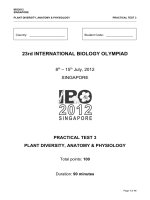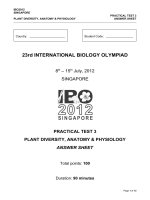Gastrointestinal anatomy and physiology the essentials (may 2014 edition)
Bạn đang xem bản rút gọn của tài liệu. Xem và tải ngay bản đầy đủ của tài liệu tại đây (2.69 MB, 200 trang )
The Essentials
Edited by
John F. Reinus, MD,
Montefiore Medical Center and The Albert Einstein College of Medicine, NY, USA
Douglas Simon, MD,
Jacobi Medical Center and The Albert Einstein College of Medicine, NY, USA
Gastroenterologists require detailed knowledge regarding the
anatomy of the GI system in order to understand the disturbances
caused by diseases they diagnose and treat.
Titles of
Related Interest
To make that information easily accessible, Gastrointestinal
Anatomy and Physiology: The Essentials brings together the world’s
leading experts who present a comprehensive overview of the
anatomic and physiologic features of the gastrointestinal tract.
Yamada’s Handbook of
Gastroenterology
Full color and with excellent anatomical and clinical figures
throughout, it provides succinct, authoritative, and didactic
anatomic and physiologic information on all the key areas, including:
• GI motility
• hepatic structure
• GI hormones
• gastric secretion
• absorption of nutrients
GI trainees will value the clear-cut, straightforward guidance, as
well as the self-assessment questions written to the level they
will encounter during Board exams, and gastroenterologists will
find it useful as a handy refresher on the key topics ahead of recertification exams.
Gastrointestinal anatomy and physiology has its own resources website:
www.wiley.com/go/reinus/gastro/anatomy
This companion website includes all figures from the book
Yamada
ISBN 978-0-470-65620-4
Essentials of
Gastroenterology,
Friedman
ISBN 978-0-470-65625-9
Gastrointestinal Anatomy and Physiology The Essentials Edited by Reinus and Simon
Gastrointestinal
Anatomy and Physiology
Gastrointestinal
Anatomy and Physiology
The Essentials
Edited by
John F. Reinus and
Douglas Simon
www.wiley.com/go/gastro
Reinus_pbk_9780470674840.indd 1
04/02/14 15:00
Gastrointestinal Anatomy and Physiology
We dedicate this book to our teachers and students, and to our families, especially
our wives: Enid and Doreen, this book is for you with our undying gratitude for
your boundless love and support.
Gastrointestinal
Anatomy and
Physiology
The Essentials
Edited by
John F. Reinus,
MD
Chief of Clinical Hepatology
Division of Gastroenterology and Liver Diseases
Montefiore Medical Center
Professor of Clinical Medicine
The Albert Einstein College of Medicine
Bronx, NY, USA
Douglas Simon,
MD, FACG
Chief of Gastroenterology and Hepatology
Jacobi Medical Center
Professor of Clinical Medicine
The Albert Einstein College of Medicine
Bronx, NY, USA
This edition first published 2014 © 2014 by John Wiley & Sons, Ltd.
Registered office
John Wiley & Sons, Ltd, The Atrium, Southern Gate, Chichester, West Sussex, PO19 8SQ, UK
Editorial offices
9600 Garsington Road, Oxford, OX4 2DQ, UK
The Atrium, Southern Gate, Chichester, West Sussex, PO19 8SQ, UK
111 River Street, Hoboken, NJ 07030–5774, USA
For details of our global editorial offices, for customer services and for information about how
to apply for permission to reuse the copyright material in this book please see our website at
www.wiley.com/wiley-blackwell
The right of the author to be identified as the author of this work has been asserted in accordance with
the UK Copyright, Designs and Patents Act 1988.
All rights reserved. No part of this publication may be reproduced, stored in a retrieval system, or transmitted,
in any form or by any means, electronic, mechanical, photocopying, recording or otherwise, except as
permitted by the UK Copyright, Designs and Patents Act 1988, without the prior permission of the publisher.
Designations used by companies to distinguish their products are often claimed as trademarks. All brand
names and product names used in this book are trade names, service marks, trademarks or registered
trademarks of their respective owners. The publisher is not associated with any product or vendor
mentioned in this book. It is sold on the understanding that the publisher is not engaged in rendering
professional services. If professional advice or other expert assistance is required, the services of a
competent professional should be sought.
The contents of this work are intended to further general scientific research, understanding, and discussion
only and are not intended and should not be relied upon as recommending or promoting a specific
method, diagnosis, or treatment by health science practitioners for any particular patient. The publisher
and the author make no representations or warranties with respect to the accuracy or completeness of
the contents of this work and specifically disclaim all warranties, including without limitation any implied
warranties of fitness for a particular purpose. In view of ongoing research, equipment modifications,
changes in governmental regulations, and the constant flow of information relating to the use of
medicines, equipment, and devices, the reader is urged to review and evaluate the information provided
in the package insert or instructions for each medicine, equipment, or device for, among other things,
any changes in the instructions or indication of usage and for added warnings and precautions. Readers
should consult with a specialist where appropriate. The fact that an organization or Website is referred to
in this work as a citation and/or a potential source of further information does not mean that the author
or the publisher endorses the information the organization or Website may provide or recommendations it
may make. Further, readers should be aware that Internet Websites listed in this work may have changed
or disappeared between when this work was written and when it is read. No warranty may be created
or extended by any promotional statements for this work. Neither the publisher nor the author shall
be liable for any damages arising herefrom.
Library of Congress Cataloging-in-Publication Data
Gastrointestinal anatomy and physiology : the essentials / edited by John F. Reinus, Douglas Simon.
p. ; cm.
Includes bibliographical references and index.
ISBN 978-0-470-67484-0 (pbk. : alk. paper)
I. Reinus, John, editor of compilation. II. Simon, Douglas, 1956– editor of compilation. [DNLM:
1. Digestive System–anatomy & histology. 2. Digestive System Physiological Phenomena. WI 101]
QP145
612.3–dc23
2013034304
A catalogue record for this book is available from the British Library.
Wiley also publishes its books in a variety of electronic formats. Some content that appears in print may not
be available in electronic books.
Cover image: © Dream Designs Image ID: 97229036
Cover design by Garth Stewart
Set in 9.5/13pt Meridien by SPi Publisher Services, Pondicherry, India
1 2014
Contents
Contributors, vi
Preface, ix
About the companion website, x
1 Structure and innervation of hollow viscera, 1
Laura D. Wood & Elizabeth A. Montgomery
2 Gastrointestinal hormones in the regulation of gut function in health
and disease, 15
John Del Valle
3 Gastrointestinal motility, 33
Ikuo Hirano & Darren Brenner
4 Gastrointestinal immunology and ecology, 46
Shehzad Z. Sheikh & Scott E. Plevy
5 Gastric physiology, 58
Mitchell L. Schubert
6 Structure and function of the exocrine pancreas, 78
James H. Grendell
7 Absorption and secretion of fluid and electrolytes, 92
Lawrence R. Schiller
8 Absorption of nutrients, 108
Lawrence R. Schiller
9 Hepatic structure and function, 129
Michelle T. Long & Lawrence S. Friedman
10 The splanchnic circulation, 149
Peter R. Kvietys & D. Neil Granger
11 Composition and circulation of the bile, 164
Allan W. Wolkoff
12 Bilirubin metabolism, 173
Allan W. Wolkoff
Index, 183
v
Contributors
Darren Brenner, MD
Assistant Professor of Medicine
Division of Gastroenterology
Northwestern University Feinberg School of Medicine
Chicago, IL, USA
John Del Valle, MD
Professor and Senior Associate Chair of Medicine
Department of Internal Medicine
Division of Gastroenterology
University of Michigan Medical Center
Ann Arbor, MI, USA
Lawrence S. Friedman, MD
Professor of Medicine
Harvard Medical School
Professor of Medicine
Tufts University School of Medicine
Assistant Chief of Medicine
Massachusetts General Hospital
Boston, MA, USA
The Anton R. Fried, MD, Chair
Department of Medicine
Newton-Wellesley Hospital
Newton, MA, USA
D. Neil Granger, PhD
Boyd Professor & Head
Department of Molecular & Cellular Physiology
LSU Health Sciences Center
Shreveport, LA, USA
James H. Grendell, MD
Professor of Medicine
School of Medicine
State University of New York at Stony Brook
Stony Brook, NY, USA
Chief, Division of Gastroenterology, Hepatology & Nutrition
Winthrop University Hospital
Mineola, NY, USA
vi
Contributors vii
Ikuo Hirano, MD
Professor of Medicine
Fellowship Program Director
Division of Gastroenterology
Northwestern University Feinberg School of Medicine
Chicago, IL, USA
Peter R. Kvietys, PhD
Professor of Physiology
College of Medicine
Alfaisal University
Riyadh, Saudi Arabia
Michelle T. Long, MD
Fellow, Division of Gastroenterology
Boston University School of Medicine and
Boston Medical Center
Boston, MA, USA
Elizabeth A. Montgomery, MD
Professor of Pathology, Oncology, and Orthopedic Surgery
Department of Pathology
Johns Hopkins Hospital
Baltimore, MD, USA
Scott E. Plevy, MD
Associate Professor
Departments of Medicine, Microbiology and Immunology
University of North Carolina School of Medicine
Chapel Hill, NC, USA
Lawrence R. Schiller, MD
Professor of Medicine
Dallas Campus, Texas A&M College of Medicine
Attending Physician
Digestive Health Associates of Texas
Program Director
Gastroenterology Fellowship
Baylor University Medical Center
Dallas, TX, USA
Mitchell L. Schubert, MD
Professor of Medicine and Physiology
Virginia Commonwealth University’s Medical College of Virginia
Chief, Division of Gastroenterology
McGuire Veterans Affairs Medical Center
Richmond, VA, USA
viii Contributors
Shehzad Z. Sheikh, MD, PhD
Assistant Professor of Medicine
Division of Gastroenterology and Hepatology
University of North Carolina School of Medicine
Chapel Hill, NC, USA
Allan W. Wolkoff, MD
The Herman Lopata Chair in Liver Disease Research
Professor of Medicine and Anatomy and Structural Biology
Associate Chair of Medicine for Research
Chief, Division of Gastroenterology and Liver Diseases
Director, Marion Bessin Liver Research Center
Albert Einstein College of Medicine and Montefiore Medical Center
Bronx, NY, USA
Laura D. Wood, MD, PhD
Assistant Professor of Pathology and Oncology
Department of Pathology
Johns Hopkins Hospital
Baltimore, MD, USA
Preface
A relatively detailed understanding of normal organ structure and function is
essential to adequately evaluate, diagnose, and manage disease. The American
Board of Internal Medicine has endorsed this proposition by including questions about the normal anatomy and physiology of digestive organs in the
Gastroenterology Certification Examination. According to a statement published
by the Board, approximately 10% of the Certification Examination questions
test knowledge of these subjects.
Many years ago, during our training, we had our first discussion of how best
to learn about gastrointestinal anatomy and physiology. Predominantly regional
organization made it difficult to acquire an overall understanding of many important topics by studying some standard texts: in these books, conceptually related
information about microscopic anatomy, motility, absorption and secretion, and
of other topics was divided among chapters principally devoted to major organs,
for example, the stomach or the small bowel. In addition, the overwhelming
quantity of information in reference works made finding and selecting the details
that were relevant to clinical practice a near-impossible task, at least from the
point of view of two novice practitioners.
Several years later, we were able to persuade the members of the Educational
Affairs Committee of the American College of Gastroenterology to allow us to
create a review course dedicated exclusively to the subjects of normal gastrointestinal structure and function. Until its recent discontinuation, this course was
offered every other year at the College’s annual meeting in conjunction with its
regular board review. Hundreds of gastroenterologists have benefited from the
excellent presentations made at the course by many of the same individuals
who have contributed chapters to this book.
It is, therefore, with great pleasure that we have seized the opportunity
offered us by the people at Wiley to address in book form the subject of basic
gastrointestinal structure and function. Our intention is to create a review
from the perspective of what is needed to practice clinical gastroenterology and
to present it in chapters devoted to specific topics in anatomy and physiology.
We hope you enjoy it.
John F. Reinus and Douglas Simon
The Albert Einstein College of Medicine
ix
About the companion website
Gastrointestinal anatomy and physiology has its own resources website:
www.wiley.com/go/reinus/gastro/anatomy
The website includes all figures from the book
x
Chapter 1
Structure and innervation
of hollow viscera
Laura D. Wood & Elizabeth A. Montgomery
Department of Pathology, Johns Hopkins Hospital, Baltimore, MD, USA
The tubular gastrointestinal (GI) tract consists of hollow organs composed of
distinct tissue layers: mucosa, submucosa, muscularis propria, and serosa or
adventitia. The mucosa of each GI organ has a unique cellular structure, whereas
the other layers are similar throughout the GI tract. Innervation of the hollow
viscera consists of postsynaptic sympathetic and presynaptic parasympa
thetic neurons with parasympathetic ganglion cells present in the myenteric
(Auerbach’s) and submucosal (Meissner’s) plexi. It is important to note that
there is more lymphoid tissue (mucosa-associated lymphoid tissue) in the GI
tract than there is in all the rest of the body combined.
The mucosa
The mucosa is the innermost layer of the GI tract; its function will be discussed
in detail in the succeeding text. The mucosa has three components:
1 The epithelium, which has protective and secretory or absorptive properties.
2 The lamina propria, a loose connective tissue zone supporting the avascular
epithelium. In the esophagus, stomach, and small intestine, but not the
colorectum, the lamina propria has many lymphatics, allowing mucosal
tumors to easily invade the lymphatics of the upper GI tract. In the upper
GI tract, there are fewer immune cells (lymphoid and plasma cells) in
the lamina propria than there are in the lamina propria of the small
bowel and colon.
3 The muscularis mucosae, a narrow double layer of inner circular and
outer longitudinal smooth muscle separating the mucosa from the
submucosa. The muscularis mucosae resembles the muscularis propria but
in miniature.
Gastrointestinal Anatomy and Physiology: The Essentials, First Edition. Edited by John F. Reinus and Douglas Simon.
© 2014 John Wiley & Sons, Ltd. Published 2014 by John Wiley & Sons, Ltd.
www.wiley.com/go/reinus/gastro/anatomy
1
2 Chapter
1
The submucosa
The submucosa is composed of connective tissue and contains Meissner’s nerve
plexus as well as large-caliber blood vessels.
The muscularis propria
The muscularis propria gives structural strength to the hollow viscera. It is composed of an inner circular and outer longitudinal layer of smooth muscle.
Between these layers is Auerbach’s nerve plexus.
Serosa or adventitia
The outermost layer of the GI tract is either a serosa or an adventitia. The latter
is distinguished by its lack of a mesothelial membrane lining.
Parasympathetic ganglion cells are found in Meissner’s and Auerbach’s nerve
plexi. The submucosal Meissner’s plexi also contain neuronal cell bodies of the
intrinsic sympathetic nerve system that function on the local area of the gut.
These are the neurons that have chemoreceptors and mechanoreceptors. They
synapse on both other ganglion cells and on muscle and secretory cells.
Esophagus
The esophagus is about 25 cm in length and consists of a cervical and upper-,
mid-, and lower-thoracic segments. It is physiologically constricted by the cricoid
cartilage, the aortic arch, the left atrium, and the diaphragm. The esophagus is
unique among the hollow viscera in that it has skeletal (voluntary) muscle,
which surrounds its upper portions. The vagus nerve provides the esophagus
with parasympathetic innervation, whereas its sympathetic innervation is from
the cervical and paravertebral ganglia.
Histologically, the squamous mucosa of the esophagus is heaped up in folds
(Figure 1.1a and b). The mitotically active basal layer matures completely into
a surface layer containing tonofilaments within 10 days. The basal layer comprises about 15% of the esophageal epithelial thickness. The cells become flatter
and more eosinophilic as they approach the surface. The normal esophageal
epithelium lacks a granular layer (present in skin) and does not keratinize.
A small number of T lymphocytes are normally present in the epithelium.
Beneath the esophageal epithelium is the lamina propria, which contains
numerous small capillary-sized blood vessels and lymphatics as well as elastic
fibers. The esophageal lamina propria has very few lymphocytes and essentially no
Structure and innervation of hollow viscera 3
Mucosa
Submucosa
Muscularis
propria
Serosa/
adventitia
(a)
(b)
(c)
(d)
Figure 1.1 Normal histology of the esophagus. (a) Low-power image (H&E stain) of normal
esophagus illustrating the characteristic layers of the wall – mucosa, submucosa, muscularis
propria, and adventitia/serosa. A submucosal gland can be seen at the right side of the image.
(b) Medium-power image (H&E stain) of the esophageal mucosa, with stratified squamous
epithelium, lamina propria, and muscularis mucosae. Note the rich vascularity in the lamina
propria. (c) High-power image (H&E stain) of an esophageal submucosal gland. (d) High-power
image (PAS-AB stain) of an esophageal submucosal gland with characteristic dark blue color.
eosinophils or plasma cells. The lymphovascular network of the lamina propria
facilitates spread of invading cancers, as do similar networks in the stomach and
small intestine (but not the colon).
The muscularis mucosae of the esophagus is a slender layer that rapidly
thickens in response to injury; resultant reduplication of this layer may make
cancer staging difficult. Normally, the smooth muscle fibers of the muscularis
mucosae are mostly longitudinal in orientation. There is no skeletal muscle in the
esophageal muscularis mucosae (in contrast to the esophageal muscularis propria
which contains skeletal muscle fibers). In the upper esophagus, the muscularis
mucosae blends with the fibrous membrane of the hypopharynx, whereas in the
lower esophagus, it merges with the muscularis mucosae of the stomach.
The submucosa of the esophagus is composed of loose connective tissue with
abundant elastic fibers, a rich lymphovascular network that has well-developed
venous plexi, scattered ganglion cells, and nerve fibers of Meissner’s plexus.
4 Chapter
1
The esophageal submucosa also contains glands (Figure 1.1c and d). These glands
are composed of mucin-producing cells that are deeply alcianophilic on periodic
acid–Schiff–Alcian blue (PAS-AB) staining. They may undergo various types of
metaplasia in response to injury. Ducts lined by cuboidal epithelium convey
mucus secreted by the glands to the luminal surface of the esophagus where it
lubricates the passage of food.
The esophageal muscularis propria is composed of striated muscle in the
upper esophagus, smooth muscle in the lower esophagus, and a mixture of the
two in between. The amounts of smooth and striated muscle are said to become
equal about 5 cm below the esophageal–pharyngeal junction. There is a welldeveloped neural plexus (Auerbach’s plexus) between the inner circular and
outer longitudinal muscle layers. The inner circular layer of the lower esophagus, or lower esophageal sphincter (LES), contracts or relaxes in response to
gastrin or secretin. There are no specific histologic features that distinguish the
LES from the rest of the muscularis propria.
The esophagus has an adventitia, a layer of coarse connective tissue that
connects the esophagus to adjoining structures, in particular the mediastinum.
The adventitia contains thick nerves, blood vessels, and lymphatics.
Stomach
The stomach has four parts, each with different mucosal features: the cardia
(most proximal), fundus, body, and antrum (most distal). The cardia and antrum
are histologically similar and have the function of protecting the esophagus
(cardia) or duodenum (antrum) from the acid and enzymes present in the rest
of the organ. The cardia expands, and may even be acquired, as a result of acid
injury and other insults in the region of the gastroesophageal junction [1–5].
The stomach receives sympathetic innervation from the celiac plexus and
parasympathetic innervation from the vagus nerve.
The luminal surface of the empty stomach has thick longitudinal folds, or
rugae, with tiny surface invaginations called gastric pits, which allow gastric
glandular secretions to reach the mucosal surface. These glands, regardless of
their location in the stomach, have an isthmus, neck, and base and are complex,
convoluted structures that are difficult to visualize in three dimensions based on
their microscopic appearance in two dimensions (Figure 1.2a and b). The entire
surface of the stomach, including the gastric pits, is lined by foveolar cells that
secrete neutral mucin and appear pink on PAS stain (Figure 1.2c and d).
The glands of the gastric body and fundus are similar in structure. The most
common cell type of the gland isthmus is the mucous neck cell. These cells also
are found in the neck where parietal (oxyntic) cells are most numerous. The chief
cell is found at the base of the gland. The areas of the gland with parietal and chief
cells do not stain with PAS-AB because they do not contain mucin (Figure 1.2d).
Structure and innervation of hollow viscera 5
Mucosa
Submucosa
Muscularis
propria
Serosa
(a)
(b)
(c)
(d)
(e)
Figure 1.2 Normal histology of the stomach. (a) Low-power image (H&E stain) of normal
stomach (body) illustrating the characteristic layers of the wall – mucosa, submucosa,
muscularis propria, and serosa. (b) Medium-power image (H&E stain) of transitional gastric
epithelium. On the right, oxyntic epithelium consists of surface foveolar cells overlying
oxyntic glands with parietal and chief cells. On the left, antral epithelium consists of foveolar
cells overlying mucin-producing antral glands. (c) Medium-power image (PAS-AB stain) of
antral epithelium, illustrating the bright pink staining of both the foveolar cells and the antral
glands. (d) Medium-power image (PAS-AB) stain of oxyntic epithelium, with bright pink
staining of foveolar cells but lack of staining in the parietal and chief cells of the oxyntic
glands. (e) Antral mucosa (gastrin immunohistochemical stain), illustrating the presence of
gastrin-producing G cells in the antral glands. Gastrin immunohistochemical stain is negative
in oxyntic mucosa and in cardiac mucosa.
6 Chapter
1
Endocrine cells are found in the deep isthmus toward the gland base. The cardiac
and antral glands are neutral mucin-producing glands that stain pink with PAS-AB
(Figure 1.2c). The cardia and antrum are very similar histologically, but the antrum
contains G cells, whereas the cardia does not (Figure 1.2e).
The G cells of the antrum secrete gastrin, which stimulates enterochromaffinlike cells of the gastric body and fundus to secrete histamine. Histamine in turn
stimulates acid secretion by parietal cells of the gastric body and fundus. In
addition, gastrin has a trophic effect on parietal cells. The antrum also contains
D cells that secrete somatostatin, which inhibits G-cell gastrin secretion. All
these endocrine interactions are important in disease states. For example, in
autoimmune gastritis, patients have immune damage to parietal cells that results
in hypergastrinemia, because antral G cells secrete excess gastrin in an attempt
to stimulate acid production. Autoimmune damage to parietal cells, which produce intrinsic factor, results in pernicious anemia.
The lamina propria of the stomach contains small numbers of plasma cells,
eosinophils, mast cells, and lymphocytes. Lymphatics and blood vessels are less
numerous than they are in the lamina propria of the esophagus. Scattered lymphoid aggregates are present. Bacteria are absent from normal gastric mucosa,
whereas mucosal bacteria are seen in the esophagus and ileocolon.
The muscularis mucosae of the stomach contains an inner circular and outer
longitudinal layer of smooth muscle. In some instances, a third slim circular layer
is present.
The submucosa of the stomach is formed of connective tissue with elastic
fibers and has prominent blood vessels, as does the lamina propria of other parts
of the tubular GI tract. Meissner’s plexus is found in the gastric submucosa.
The gastric muscularis propria consists of three fairly indistinct layers: an
inner oblique, middle circular, and outer longitudinal layer. The layers are somewhat randomly oriented and may be absent or poorly developed in some areas.
This random arrangement of muscle fibers is typical of hollow organs that expel
their contents (e.g., uterus, urinary bladder, gallbladder). The muscularis propria
contains Auerbach’s plexus and ganglion cells. Interstitial cells of Cajal (ICCs),
also called “pacemaker” cells, can be readily identified in the muscularis propria
using immunolabeling with antibodies directed against CD117 (c-kit protein).
The stomach is encased by a serosa that is composed of connective tissue and
a lining of flat-to-cuboidal peritoneal cells, a unique type of modified epithelial
cell. This contrasts with the connective tissue covering the esophagus.
Small bowel
The small bowel is divided into three major sections. The duodenum extends
from the gastric pylorus to the ligament of Treitz and is formed sequentially of a
bulb and descending, horizontal, and ascending portions. The duodenum is
Structure and innervation of hollow viscera 7
Mucosa
Submucosa
Muscularis
propria
Serosa
(a)
(b)
(c)
Figure 1.3 Normal histology of the small bowel. (a) Low-power image (H&E stain) of normal
small bowel with plicae circulares and epithelial villi. The small bowel contains the same layers
as the other organs of the tubular GI tract – mucosa, submucosa, muscularis propria, and serosa.
(b) Medium-power image (H&E stain) of the duodenal mucosa and submucosa, illustrating the
presence of Brunner’s glands in the lamina propria and submucosa. Strictly speaking, Brunner’s
glands should be restricted to the submucosa, but most adult patients have Brunner’s glands in
the duodenal lamina propria, presumably a reparative change. (c) Medium-power image
(PAS-AB stain) of the duodenal mucosa and submucosa, illustrating the bright pink staining of
Brunner’s glands. Note that the goblet cells contain alcianophilic purple-colored mucin, whereas
the absorptive cells lack mucin.
mostly retroperitoneal, whereas the jejunum and ileum are intraperitoneal. The
jejunum is distal to the ligament of Treitz and consists, somewhat arbitrarily, of
the proximal third of the intraperitoneal small bowel. The jejunum narrows into
the ileum, which is formed by the distal two-thirds of the intraperitoneal small
bowel and joins the colon at the ileocecal valve. These sections of the small bowel
receive parasympathetic innervation from the vagus nerves and sympathetic
innervation from the celiac plexus.
Like the esophagus and stomach, the small bowel wall consists of layers:
mucosa (epithelium, lamina propria, muscularis mucosae), submucosa, muscularis propria, and serosa or adventitia (Figure 1.3a). The unique gross and
microscopic anatomy of the small bowel reflects its principal function,
absorption of nutrients. Macroscopic plicae circulares and microscopic villous
8 Chapter
1
projections of the epithelium and lamina propria give a tube 6–7-m long an
absorptive surface of 200–500 m2. Villi are broad in the duodenum and ileum
and are long and thin in the jejunum. In between villi, the epithelium forms
invaginations, or glands, referred to as “crypts of Lieberkühn.” The villus-tocrypt height ratio is quite variable throughout the small bowel, ranging from
2–3:1 in the proximal duodenum to 4–5:1 in the jejunum.
Small bowel villi and crypts are lined mainly by absorptive cells that have a
microvillus brush border consisting of numerous cytoplasmic projections that
further expand the enterocyte’s absorptive surface. Absorptive cells of the
small bowel lack mucin, including the neutral mucin found in the foveolar
cells of the stomach [6]. Although most epithelial cells are absorptive, the epithelium also contains scattered goblet cells with large vacuoles of acid mucin.
There also are scattered Paneth cells in the crypts of the small bowel, with basal
nuclei and red granular apical cytoplasm, as well as endocrine cells with apical
nuclei and granular basal cytoplasm. These two cell types have a similar
appearance but opposite orientation relative to the basement membrane, and
the granules of endocrine cells are smaller than those of Paneth cells. Paneth
cells have large eosinophilic granules containing growth factors and antimicrobial proteins, while endocrine cells have fine granules containing a variety of
peptides and bioactive compounds.
The lamina propria of the small bowel contains numerous lymphocytes and
plasma cells (primarily IgA-secreting) as well as scattered eosinophils. Capillaries
and lacteals, blindly ending lymphatic vessels that absorb chylomicrons, are
found in the lamina propria at the tips of the villi. The lamina propria of the villi
also contains delicate strands of smooth muscle.
The small bowel muscularis mucosae consists of slim inner circular and
outer longitudinal layers of smooth muscle. The crypt bases reach the top of
the muscularis mucosae.
The small bowel submucosa is composed of loose connective tissue and
contains large-caliber vessels and Meissner’s nerve plexus of both parasympathetic
ganglion cells and sympathetic neurons. In the duodenum, the submucosa is
the site of Brunner’s glands, mucin-producing glands that are unique to the
duodenum and contain neutral mucin (Figure 1.3b and c). The submucosa also
contains lymphoid aggregates, often with germinal centers. These lymphoid
aggregates, or Peyer’s patches (PPs), are present throughout the small bowel but
are most numerous in the ileum. While they have a linear orientation in the
duodenum and jejunum, they are arrayed circumferentially in the ileum where
they create a potential for intussusception if they undergo hypertrophy.
Numerous intraepithelial lymphocytes (IELs) are present in the epithelium overlying the PPs; these lymphocytes communicate with the rest of the lymphoid
compartment through specialized epithelial cells known as M cells.
The muscularis propria is a thick double layer of inner circular and outer
longitudinal muscle that generates the propulsive action of the bowel wall and
Structure and innervation of hollow viscera 9
is the source of most of its tensile strength. Auerbach’s nerve plexus of
parasympathetic ganglion cells is located between the muscle layers.
The outermost layer of the intraperitoneal small bowel (jejunum and ileum)
is serosa. The retroperitoneal small bowel (duodenum) is covered by mesothelium on its anterior surface only; the posterior surface is covered by loose
connective tissue, so the duodenum has an anterior serosa and a posterior
adventitia.
Colon and rectum
The colon has several anatomically distinct parts: The cecum and ascending colon
are fixed by mesentery to the posterior right abdominal wall; only their anterior
surfaces are covered by peritoneal mesothelium. The transverse colon is suspended
in the abdominal cavity by the lesser omentum and is completely covered by
serosa. The descending colon is adherent to the posterior left abdominal wall and,
like the ascending colon, only has a peritoneal membrane on its anterior surface.
The sigmoid colon is the only part of the colon suspended entirely by mesentery
and is therefore completely covered by serosa. The rectum is adherent to the posterior abdominal wall. The colon receives parasympathetic innervation from the
vagus nerve proximally and pelvic splanchnic nerves distally. Its sympathetic
innervation comes from the superior and inferior mesenteric plexi.
Like the rest of the hollow viscera, the colon has a layered bowel wall with a
mucosa (epithelium, lamina propria, muscularis mucosae), submucosa, muscularis propria, and serosa or adventitia (Figure 1.4a). Because the function of the
colon is to absorb water and electrolytes, its mucosal architecture is different from
that of the small bowel. Grossly, the colon has transverse mucosal folds, plicae
semilunares, with haustral sacs between the folds. The colonic mucosa, unlike
the small bowel mucosa, is mostly flat, although it may have smooth undulations
known as anthemic folds. The colon epithelium does not have villi; it has straight
invaginations called crypts, which line up like “test tubes in a rack” (Figure 1.4b).
The crypt epithelium mostly consists of goblet cells, each with a single large
mucin vacuole, but a few absorptive cells also are present [7]. Scattered IELs normally are found throughout the colon [8]. In the bases of the crypts, there are
precursor cells as well as endocrine cells that exhibit the same morphology as
endocrine cells in the small intestine. Paneth cells, with basal nuclei and apical
red granular cytoplasm like those in the small intestine, normally are present in
the crypt bases of the ascending and transverse colons but are absent from the
crypts of the normal descending and sigmoid colons.
The colonic lamina propria contains a mixture of lymphocytes, plasma
cells, and eosinophils. Inflammatory cells are more abundant in the lamina
propria of the ascending colon than in that of the descending colon; therefore,
knowledge of biopsy location is necessary to accurately interpret signs of
10 Chapter
1
Mucosa
Submucosa
Muscularis
propria
Serosa
(a)
(b)
(c)
(d)
Figure 1.4 Normal histology of the colon. (a) Low-power image (H&E stain) of normal colon
illustrating the characteristic layers – mucosa, submucosa, muscularis propria, and serosa. Large
vessels are apparent in the submucosa but not the lamina propria. (b) Medium-power image
(H&E stain) of normal colonic mucosa, with regular crypts lined by mucin-producing goblet cells
arranged like “test tubes in a rack” and abuting on the muscularis mucosae. (c) Muscularis
propria of the colon (CD117 immunohistochemical stain), illustrating the presence of numerous
ICCs scattered throughout the muscularis propria. (d) Lamina propria of the colon (CD117
immunohistochemical stain), illustrating the (normal) presence of mast cells in the lamina
propria – these cells should not be confused with ICCs, which are also positive for CD117.
inflammation. Importantly, the lamina propria of the colon lacks lymphatic
vessels, a critical point in the staging of invading neoplasms. Whereas neoplasms invading the lamina propria of other parts of the GI tract may metastasize, those that penetrate the colonic lamina propria are considered in situ
lesions (intramucosal carcinoma), as the lack of lymphatics reduces the
likelihood of metastasis.
Beneath the lamina propria is the slender colonic muscularis mucosae, with
inner circular and outer longitudinal layers of smooth muscle. In the normal
colon, the crypt bases line up evenly along the top of the muscularis mucosae.
The submucosa of the colon is composed of loose connective tissue and contains large-caliber vessels as well as Meissner’s nerve plexus of parasympathetic
ganglion cells and sympathetic neurons.
Structure and innervation of hollow viscera 11
The colonic muscularis propria has inner circular and outer longitudinal
muscle layers that, as in the rest of the luminal gut, generate propulsive
action and are a source of tensile strength. Auerbach’s nerve plexus of
parasympathetic ganglion cells is located between the layers and includes
ICCs, also called pacemaker cells (Figure 1.4c). The muscularis propria of the
colon is unique in that the circular muscle is continuous throughout the
length and circumference of the colon, whereas the outer longitudinal layer
is discontinuous. The longitudinal smooth muscle is arrayed in three symmetrically positioned bundles, the tenia coli. One is at the site of the colon’s
mesenteric attachment (tenia mesocolica), another is at the site of the attachment of the greater omentum to the transverse colon (tenia omentalis), and
a third band is “free” (tenia libera). Polypoid collections of adipose tissue, the
epiploic appendages, project from the outer surface of the colon over the two
antimesenteric tenia. Blood vessels enter the bowel wall on either side of the
tenia mesocolica and on the mesenteric sides of the tenia omentalis and the
tenia libera. These sites of entry create weak points in the bowel wall where
colonic diverticula may develop.
The proximal half of the rectum is within the abdominal cavity and is
covered by peritoneum; the distal half is embedded in the soft tissue of the
pelvis and lacks a peritoneal covering. This point is crucial to the evaluation of
surgical specimens, as the external surface of the distal rectum represents a
true surgical margin rather than a peritonealized surface. In the distal rectum,
the teniae coli merge to once again form a continuous layer of longitudinal
smooth muscle.
Although the rectal mucosa has the same basic components as do the
mucosal surfaces of the rest of the colon, it also has some unique features. The
rectal crypts are often shorter, with wider and less regular spacing. These crypts
may be less numerous and have irregular shapes.
The lamina propria of the rectum is often more cellular than that of the
descending and sigmoid colons, with lymphocytes, plasma cells, neutrophils,
and mucoprotein-containing histiocytes (muciphages). Mild fibrosis also may
be seen.
Anus
Where the bowel joins the anal canal, the transverse plicae semilunares are
replaced by longitudinal anal columns. These columns terminate in the anal
valves, which contain the anal sinuses, mucosal recesses into which the mucinproducing anal glands empty. This circumferential ring of anal valves is also
known as the dentate line.
The anal mucosa can be divided into three regions based on the characteristics of its epithelial lining (Figure 1.5a). There is, however, considerable individual
12 Chapter
1
Mucosa
Submucosa
Muscularis
propria
Adventitia
(b)
(a)
(c)
Figure 1.5 Normal histology of the anus. (a) Low-power image (H&E stain) of anus with
dilated hemorrhoidal blood vessels in the submucosa. The mucosa consists of colonic (right),
transitional (center), and squamous (left) regions. The anus consists of the characteristic layers,
with an adventitia due to its retroperitoneal location. (b) High-power image (H&E stain) of a
submucosal anal gland. (c) Medium-power image (H&E stain) of dilated hemorrhoidal vessels
in the submucosa of the anus.
variation in the extent of these epithelial areas. Proximally, the anal epithelium
is similar to the columnar epithelium of the rectum and has crypts lined mostly
by goblet cells. Distally, the anus has a nonkeratinizing stratified squamous epithelium that becomes keratinized skin with adnexal structures distal to the anal
verge. The transition from columnar to squamous epithelia, usually located in
the region of the dentate line, is quite variable in appearance. In some cases,
columnar rectal epithelium is located directly adjacent to stratified squamous
epithelium with little if any intervening transitional epithelium. In other cases,
the columnar and squamous epithelia are separated by a transitional epithelium
consisting of four to nine layers of stratified cuboidal cells that are neither
squamous nor columnar (with a similar morphology to the transitional epithelium of the urinary bladder).
In all three regions, the characteristic layers of the tubular gut underlie the
anal epithelium. The anal submucosa, muscularis mucosae, and lamina propria
Structure and innervation of hollow viscera 13
are similar to those elsewhere in the GI tract, with unique anal glands in the
submucosa (Figure 1.5b). In addition, the submucosa of the anus frequently
contains dilated hemorrhoidal blood vessels (Figure 1.5c).
Due to its role in regulation of defecation, the musculature of the anus
(including the muscularis propria) forms unique sphincters. The smooth
muscle of the anal muscularis propria forms the involuntarily controlled
internal anal sphincter, while anorectal skeletal muscle forms the voluntarily
controlled external anal sphincter. The parasympathetic innervation of the
anus comes from the pelvic splanchnic nerves, and the sympathetic innervation comes from the inferior mesenteric plexus.
The anus lies embedded in the soft tissue of the pelvis covered by an adventitia of loose connective tissue.
Multiple choice questions
1 Which of the following cell types is present in the small bowel and ascending colon but not
in the descending colon?
a Endocrine cells
b Goblet cells
c Paneth cells
d Plasma cells
e Eosinophils
2 Which of the following organs lacks lymphatic vessels in the lamina propria?
a Esophagus
b Stomach
c Small bowel
d Colon
e All of the above
3 Which of the following choices correctly pairs the nerve plexi with their locations?
a Meissner’s plexus in lamina propria, Auerbach’s plexus in submucosa
b Meissner’s plexus in submucosa, Auerbach’s plexus in muscularis propria
c Meissner’s plexus in muscularis propria, Auerbach’s plexus in muscularis mucosae
d Meissner’s plexus in muscularis mucosae, Auerbach’s plexus in serosa
e Meissner’s plexus in serosa, Auerbach’s plexus in lamina propria
4 Which of the following layers would be present in a mucosal biopsy?
1) Lamina propria
2) Muscularis propria
3) Epithelium
4) Serosa
5) Submucosa
6) Muscularis mucosae
a 1, 3, 6
b 2, 3, 5
c 1, 2, 3, 5
d 2, 4, 5
e 3, 4, 5, 6









